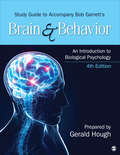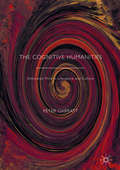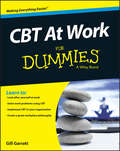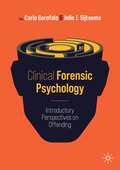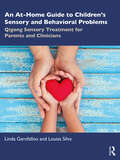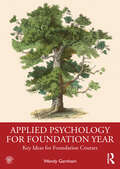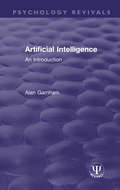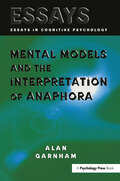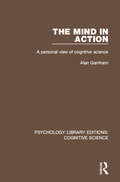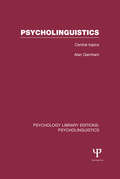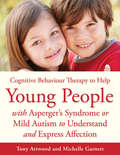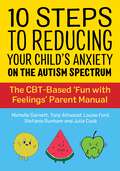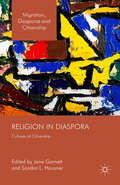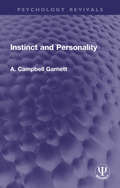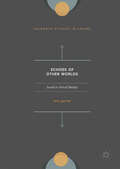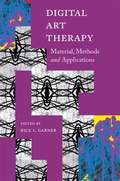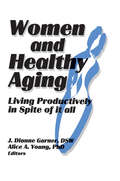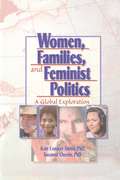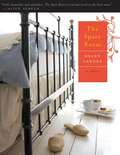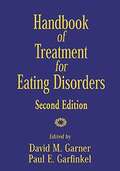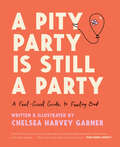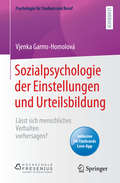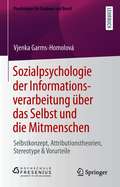- Table View
- List View
Study Guide to Accompany Bob Garrett’s Brain & Behavior: An Introduction to Biological Psychology
by Bob GarrettRevised by Gerald Hough to accompany the Fourth Edition of Bob Garrett’s best seller, Brain & Behavior: An Introduction to Biological Psychology, the fully updated Student Study Guide provides additional opportunities for student practice and self-testing. Featuring helpful practice exercises, short answer/essay questions, as well as post-test multiple choice questions, the guide helps students gain a complete understanding of the material presented in the main text. Save your students money! Bundle the guide with the main text. Use Bundle ISBN: 978-1-4833-1832-5. The main text, Brain & Behavior: An Introduction to Biological Psychology, Fourth Edition, showcases our rapidly increasing understanding of the biological foundations of behavior, engaging students immediately with easily accessible content. Bob Garrett uses colorful illustrations and thought-provoking facts while maintaining a “big-picture” approach that students will appreciate. Don’t be surprised when they reach their “eureka” moment and exclaim, “Now I understand what was going on with Uncle Edgar!”
The Cognitive Humanities: Embodied Mind in Literature and Culture
by Peter GarrattThis book identifies the ‘cognitive humanities’ with new approaches to literature and culture that engage with recent theories of the embodied mind in cognitive science. If cognition should be approached less as a matter of internal representation—a Cartesian inner theatre—than as a form of embodied action, how might cultural representation be rethought? What can literature and culture reveal or challenge about embodied minds? The essays in this book ask what new directions in the humanities open up when the thinking self is understood as a participant in contexts of action, even as extended beyond the skin. Building on cognitive literary studies, but engaging much more extensively with ‘4E’ cognitive science (embodied, embedded, enactive, extended) than previously, the book uses case studies from many different historical settings (such as early modern theatre and digital technologies) and in different media (narrative, art, performance) to explore the embodied mind through culture.
CBT at Work For Dummies
by Gill GarrattNip workplace stress in the bud with CBT Packed with useful tips that make it easy to incorporate CBT-Cognitive Behavioral Therapy- into your working day, CBT at Work For Dummies helps you reap the benefits of a more focused working life. You'll discover how integrating CBT at work promotes improved productivity and concentration, lower staff turnover, enhanced employer/employee and client relationships, reduced cost of staff absenteeism caused by illness, injury, stress, and more. An alarming number of individuals in the UK and across the globe suffer from work-related stress, some to the point of experiencing illness. The good news is, Cognitive Behavioural Therapy-often associated with treating acute mental health conditions-is finding its way into the workplace, where it's being used as a way to combat one of the most common occupational health issues: stress. In this friendly and accessible guide, you'll find everything you need to put CBT into practice today, whether you're in charge of managing employee wellness or just want to find a positive and productive way to get through the workday yourself. Answers the call of business leaders seeking creative solutions to enhance productivity and minimize the effects of stress in the workplace Offers employees trusted ways to be more effective in the workplace while reducing personal stress levels Arms learning and development professionals with the know-how to apply mindfulness meditation in the workplace Details the benefits of making CBT a part of your business plan If you're an employer looking to get the best out of your staff or an employee interested in reducing stress and anxiety whilst achieving an enhanced performance at work, CBT at Work For Dummies can help.
Clinical Forensic Psychology: Introductory Perspectives on Offending
by Carlo Garofalo Jelle J. SijtsemaThis book represents a comprehensive collection of theoretical and empirical work at the nexus of clinical and forensic psychology written by world-renowned experts in the field. It is among the first books in the field to focus entirely on clinical psychological science applied to the understanding and treatment of offending. Part I addresses the main theoretical and clinical models used to explain and predict antisocial behavior, spanning biological, cognitive, experimental, individual differences, and interpersonal perspectives. Part II focuses on forms of psychopathology associated with an increased tendency to offend, with the emphasis on describing the clinical constructs most relevant for forensic psychology. Each chapter describes the clinical characteristics of one form of psychopathology, their assessment, their links with antisocial behavior, and treatment considerations. Part III focuses on different types of offense or offender groups as starting points. This perspective has relevance since many criminal justice and forensic mental health systems allocate offenders to interventions based on their index offense (or history of offenses). Finally, Part IV addresses the application of clinical psychology in the service of assessment and treatment in forensic settings. It includes the state of the art on diagnostic and risk assessment, as well as both widely used and recently developed interventions. This book is an excellent resource for students at both Bachelor’s and Master’s level, while also representing a comprehensive handbook for experienced researchers and practitioners.
An At-Home Guide to Children’s Sensory and Behavioral Problems: Qigong Sensory Treatment for Parents and Clinicians
by Linda Garofallou Louisa SilvaAn At-Home Guide to Children’s Sensory and Behavioral Problems gives a new perspective on sensory and behavior problems, one that sees those behaviors as stemming from a child’s immature sensory nervous system and regulation difficulties. This book offers an effective at-home intervention, the Qigong Sensory Treatment, that enlists a parent's attuned touch to address often overlooked sensory issues that underlie ‘problem’ behaviors and works to organize those sensory experiences to foster connection and the capacity for self-regulation. It introduces the reader to a new and clinically useful model to understand sensory development, the Early Childhood Self-regulatory Milestones which are critical to the emotional and behavioral health and regulation for all children. With clear step-by-step instructions, diagrams, and links to online instructional videos, it teaches parents how to successfully implement the daily QST hands-on routine. Unique to the treatment model is how it guides and focuses parents to easily recognize, interpret and respond to their child's shifting non-verbal body and behavioral responses and cues. An extensive workbook section navigates parents through a year-long process of learning and implementing QST at home. Weekly letters include those written by the authors, parents who share their own personal experiences with the routine and by QST Master Trainers who offer their years of experience and helpful tips. The 52 letters are timed to anticipate and answer typical questions or stumbling blocks that parents commonly encounter at key points, guiding them to success with their child’s sensory and behavior difficulties while making for happier and less-stressful times with their child. This guide will be indispensable to parents and clinicians looking to understand and more effectively work with their child’s developmental difficulties.
Applied Psychology for Foundation Year: Key Ideas for Foundation Courses
by Wendy GarnhamApplied Psychology for Foundation Year: Key Ideas for Foundation Courses introduces students to topical issues and controversies within specific areas of applied psychology, bringing together current theories and studies from a number of areas within applied psychology through a series of interesting and current debates and controversies. Included in this book are a series of snapshots of how psychologists have tried to apply their findings to real-life problems. Using a clear structure and accessible tone, this book demonstrates how psychological research can be applied to inform current debates across a variety of the field’s subdisciplines. Through examination of both established theoretical ideas and more recent empirical evidence, it enables readers to see how research is linked to practical application in occupational psychology, educational psychology, criminology, sport psychology and environmental psychology. In doing so, it explicates contemporary theories and studies and contributes a cross-cultural understanding of these topics. This book’s wide coverage of topics and theories is designed to enable readers to not only immerse themselves in topical and often controversial debates but also to develop a critical awareness of alternative viewpoints, methodological weaknesses and theoretical shortcomings. Readers are encouraged to consider and question these theories and consider the implications of this research and how the findings can be applied to their own experience. Applied Psychology for Foundation Year is a key textbook for both foundation year and introductory psychology courses and will be of interest to anyone wanting to delve into topical issues in contemporary psychology.
Artificial Intelligence: An Introduction (Psychology Revivals)
by Alan GarnhamFirst published in 1987, this book provides a stimulating introduction to artificial intelligence (AI) - the science of thinking machines. After a general introduction to AI, including its history, tools, research methods, and its relation to psychology, Garnham gives an account of AI research in five major areas: knowledge representation, vision, thinking and reasoning, language, and learning. He then describes the more important applications of AI and discusses the broader philosophical issues raised by the possibility of thinking machines. In the final chapter, he speculates about future research in AI, and more generally in cognitive science. Suitable for psychology students, the book also provides useful background reading for courses on vision, thinking and reasoning, language and learning.
Mental Models and the Interpretation of Anaphora (Essays in Cognitive Psychology)
by Alan GarnhamThe interpretation of anaphora - how we interpret expressions such as definite pronouns (he, she, it) and verbal elliptical phrases (such as "did so, too") in the course of ordinary conversation or reading - is an important aspect of language comprehension. In this book the author examines the research and evidence on anaphor interpretation within the context of the mental models theory of comprehension, arguing that the notion of a mental model is essential to the detailed description of the processes of anaphor resolution. The general philosophy of the mental models approach and the nature of mental models themselves and their role in language processing is discussed, followed by a review of methodological issues that bear on the interpretation of psychological research findings. Against this background, the author's own research on areas such as deep and surface anaphora, reference into anaphoric islands, the role of implicit causality in anaphor resolution and the use of pronouns to refer to characters introduced by stereotyped role names is presented.At all times the author's research is set within the context of the general literature on anaphor resolution derived from the disciplines of linguistics, psycholinguistics, philosophy and computational linguistics, ensuring that the book will be of interest to advanced students and researchers in these fields.
The Mind in Action: A Personal View of Cognitive Science (Psychology Library Editions: Cognitive Science)
by Alan GarnhamCognitive science – which draws on ideas from psychology, philosophy, linguistics and artificial intelligence (AI) – attempts to explain our mental life within a scientific framework. Its goal is, thus, to remove the last major obstacle to a unified scientific account of the natural world. In this title, originally published in 1991, Alan Garnham provides an invaluable introduction to this exciting new development in the study of mind. The Mind in Action focuses on the development of a systematic explanation of cognition, rather than on facts about the way we perceive things, remember them, talk about them, think about them, and interact with them. The author looks in detail at the nature of scientific explanations, the reasons for developing them, and the way they are assessed. He describes the work carried out by cognitive scientists and considers the questions that motivate it. He introduces the computational metaphor for the mind, and explains how flushing out the metaphor might lead to an integrated scientific account of mental phenomena. Designed primarily for people about to embark on courses in cognitive science and related disciplines, The Mind in Action captures the liveliness and excitement of debates about the mind. It is readily accessible to anyone with an interest in how the mind works, avoiding technical terms where possible and explaining them fully where they are necessary.
Psycholinguistics: Central Topics
by Alan GarnhamFrom the author: This book reflects my beliefs about how psycholinguistics, and cognitive psychology in general, should be taught. Since psycholinguistics is a scientific discipline, the book discusses theories about the central cognitive aspects of language understanding, rather than presenting a morass of unstructured facts on a series of loosely connected topics. It also attempts to reflect the emergence of cognitive science, an interdisciplinary approach to the study of language and other cognitive processes. It describes not only psychological studies, but also ideas from linguistics, artificial intelligence, the philosophy of language and formal logic. There is no pretence that the discussion is exhaustive.
Psycholinguistics: Central Topics (Psychology Library Editions: Psycholinguistics)
by Alan GarnhamOriginally published in 1985, this title was an important new teaching text at the time. Alan Garnham focuses on current theories about the central cognitive aspects of language understanding, and attempts to reflect the emergence of cognitive science, an inter-disciplinary approach to the study of language and other cognitive processes. As well as describing psychological studies, the text includes ideas from linguistics, artificial intelligence, the philosophy of language and formal logic. Some introductory remarks on the study of language understanding precede a discussion of word recognition and the computation of the syntactic structure of sentences. The central part of the book is concerned with questions about meaning, the mental representation of word meanings, and text comprehension. The final two chapters address questions of how the parts of the language processing system operate together, and how language production is related to comprehension. Rather than attempting an exhaustive discussion of empirical research on his chosen topics, the author gives the reader the flavour of linguistic arguments. In particular, Psycholinguistics attempts to indicate the problems and also the possibilities of relating experimental data to theories of language processing. Psycholinguistics will still be useful reading on courses in psycholinguistics, language and thought, and cognitive psychology.
CBT to Help Young People with Asperger's Syndrome (Autism Spectrum Disorder) to Understand and Express Affection: A Manual for Professionals
by Michelle Garnett Tony AttwoodChildren and adolescents with Autism Spectrum Disorders (ASD) are often not instinctive and intuitive in expressing their liking or love for someone, or in understanding that family members, friends and others need affection. Expressing affection to teachers, other close professionals, or family friends, can be even more challenging. This book, by the leading experts in the field, provides a carefully constructed CBT programme for professionals to help boys and girls with an ASD to feel confident recognising, expressing and enjoying affection. The activities will help the young person identify their own and others' comfort and enjoyment range for gestures, actions and words of affection. They will also learn the variety of appropriate ways they can express liking or loving someone, helping them to strengthen friendships and relationships. This book will be an invaluable resource for professionals supporting a child with an ASD.
10 Steps to Reducing Your Child's Anxiety on the Autism Spectrum: The CBT-Based 'Fun with Feelings' Parent Manual
by Michelle Garnett Dr Anthony Attwood Louise Ford Julia Cook Stefanie RunhamRecognising, expressing and understanding emotions helps young children make sense of their life experiences. Children diagnosed with autism can have significant difficulties with recognising and processing emotions which can lead to high levels of anxiety as they struggle to make sense of the unpredictable world around them.The 'Fun with Feelings' programme is designed to help parents support their children with emotional regulation and to decrease anxiety. This guide is structured around 10 stages. The initial four stages prepare parents to implement the programme with their child. These stages help parents understand the causes of anxiety and provide practical strategies for creating a toolbox to reduce anxiety. The final six stages are used in conjunction with Having Fun with Feelings on the Autism Spectrum: A CBT Activity Book for Kids Age 4-8, allowing parents to support their child while working through the activity book.Written by world-leading experts in the field, 10 Steps to Reducing Your Child's Anxiety on the Autism Spectrum provides the steppingstones for parents of young children with autism to better understand their child's emotional skill set and empower them to understand and articulate their feelings.
Religion in Diaspora: Cultures of Citizenship (Migration, Diasporas and Citizenship)
by Jane Garnett Sondra L. HausnerThis edited collection addresses the relationship between diaspora, religion and the politics of identity in the modern world. It illuminates religious understandings of citizenship, association and civil society, and situates them historically within diverse cultures of memory and state traditions.
Instinct and Personality (Psychology Revivals)
by A. Campbell GarnettOriginally published in 1928, the principle aim of this book was to present and apply an original viewpoint in psychology. The work is substantially that of a thesis on "The Problem of Personality in the Light of Recent Psychology" for which the author was awarded the degree of Doctor of Letters in the University of Melbourne in 1925. Today it can be read and enjoyed in its historical context.
The Processing of Information and Structure
by W. R. GarnerFirst published in 1974. Routledge is an imprint of Taylor & Francis, an informa company.
Echoes of Other Worlds: Sound in Virtual Reality
by Tom A. GarnerThis book explores the nature and importance of sound in virtual reality (VR). Approaching the subject from a holistic perspective, the book delivers an emergent framework of VR sound. This framework brings together numerous elements that collectively determine the nature of sound in VR; from various aspects of VR technology, to the physiological and psychological complexities of the user, to the wider technological, historical and sociocultural issues. Garner asks, amongst other things: what is the meaning of sound? How have fictional visions of VR shaped our expectations for present technology? How can VR sound hope to evoke the desired responses for such an infinitely heterogeneous user base? This book if for those with an interest in sound and VR, who wish to learn more about the great complexities of the subject and discover the contemporary issues from which future VR will surely advance.
Digital Art Therapy: Material, Methods, and Applications
by Rick Garner Reina Lombardi Rachel Brandoff Noel L'Esperance Natalie Carlton Nancy S. Choe Kelly Darke Katie Hall Jukka Laine Jon Ehinger Gretchen Miller Christina Vasquez Christian Brown Catherine Hsin Brittany BarberConsidering the latest advances and developments in the arena of digital media, this book explores current materials, methods and applications of digital technology in art therapy. It looks thoroughly at the many potential uses and benefits of digital technology in art therapy practice, including the use of stop motion animation and therapeutic light painting photography. A worked example of how digital art therapy can be used in the treatment of traumatic brain injury is also included. The book explores innovative therapeutic uses of digital technologies such as gaming and virtual worlds. Contributions from experienced art therapists address professional and ethical issues, from the sensory qualities of digital media and their effects in practice, to identifying and using developmentally appropriate technologies. As art therapy programs increasingly recognize the importance of using digital media, this cutting-edge guide provides all the necessary knowledge to incorporate this emerging field into practice.
Women and Healthy Aging: Living Productively in Spite of It All
by J Dianne Garner Alice A YoungThis book explores what is known about healthy living among older women, emphasizing overcoming illness and adversity. Women and Healthy Aging focuses on common age-related changes and illnesses that frequently occur among women in the later years. It describes these diseases and changes, provides treatment options, highlights preventative measures, and offers suggestions for continued productive living as women age. Since some of the barriers to effective diagnoses, treatments, and implementation of productive living strategies are institutional, two chapters explore public health policies which affect older women and discrimination against older women in health care. This informative book assists health care professionals in the provision of services to older women, helping these professionals become catalysts for enabling older women to “overcome adversity” and continue to lead healthy, productive lives.Many of the most common diseases and age-related changes that affect older women are not “curable.” In a society which stresses “cure” as the appropriate role for health care professionals, what are these professionals to do with the legions of older women for whom “cures” may not be possible? How can they assist older women in preventing or slowing the occurrences of diseases and age-related changes? When prevention or cure is not possible, how can they assist older women in living productive, meaningful lives?By addressing specific conditions and diseases, Women and Healthy Aging gives readers focused information on current treatment options, preventative strategies, and suggestions for productive living which are disease- or condition-specific and target older women. Some of the topics covered include menopause, osteoporosis, arthritis, diabetes, heart disease, cancer, Alzheimer’s disease, and sensory loss. Practitioners, educators, and students in the fields of nursing, social work, physical therapy, occupational therapy, gerontology, human services, and medicine will find this book an illuminating source of valuable information and insights into the aging process for women.
Women, Families, and Feminist Politics: A Global Exploration
by J Dianne Garner Suzanne CherrinWomen and their roles within families must be understood within the context of ethnic traditions, religion, and culture. Women, Families, and Feminist Politics: A Global Exploration combines all of these aspects to evaluate the similarities and differences of women around the world. Readers will learn about diverse theories relating to women and their familial roles, the different categories of feminism, and how cultures and ethnic traditions shape and sometimes restrict a woman’s identity. Using feminist and sociocultural theories to critically examine the role of adult women within their families, Women, Families, and Feminist Politics offers ideas and suggestions on what has to be done in order for all of women’s experiences and concerns to be valued and looked upon as important. In addition to providing you with an understanding of how customs and cultures contribute to societal standards set for women, Women, Families, and Feminist Politics discusses several factors that contribute to the formation of women’s roles and identity, including: the economic situation of the family and the country in which the woman lives (a developed or developing country) cultural diversity in monogamous heterosexual marriage relations and specific marriage traditions, such as dowries family structures, such as nonnuclear, extended, polygamous, mixed religion relationships, mixed race relationships, or same-sex relationships reproduction and sexual standards in relation to religion, government policies, and world population gender equity in the workplace and programs for women in global development the health care needs of women and how they vary depending on culture, political philosophies, and resources women and violence in societal and family contexts, from war rapes, female circumcision, and footbinding to battery and sexual harassmentWomen, Families, and Feminist Politics looks at the daily challenges and concerns of adult women within the context of family to help you understand the different needs of women in relation to their culture and ethnic background. Focusing on the importance of views concerning the meaning of women’s social status, power, and success, Women, Families, and Feminist Politics contains case studies and statistical data that identify critical issues pertaining to you personally and to all women throughout the world. By understanding how women’s families help shape their identities, you will be able to learn about the vast experiences of women and the inequalities we have yet to overcome.
The Spare Room
by Helen GarnerIn this short but very direct novel, Helen Garner explores the question: how much of ourselves must we give up to help a friend in need? Helen has little idea what lies ahead--and what strength she must summon--when she offers her spare room to an old friend, Nicola, who has arrived in Melbourne from Sydney for cancer treatments and who is skeptical of the medical establishment, placing all her faith in an alternative health center. Nicola is determined to find her own way to cope, regardless of the advice Helen offers. In the weeks that follow, Nicola's battle for survival will turn not only her own life upside down but also those of everyone around her. Helen unexpectedly finds herself driven through extremes of rage and tenderness to become Nicola's nurse, protector, guardian angel, and stony judge. Powerful and taut, and full of wisdom and dark laughter, The Spare Room is a magical gem of a book that packs a huge punch.
Handbook of Treatment for Eating Disorders
by David M. Garner Paul E. GarfinkelIn this seminal work, leading clinicians and researchers present the major treatments for eating disorders, including cognitive-behavioral, educational, psychodynamic, feminist, family-based, and medical approaches. <p><p>Therapeutic approaches are described in step-by-step detail and illustrated with extensive case material. Several chapters function as self-contained treatment manuals, enabling practitioners to easily learn and implement each model, as well as adapt it to suit the needs of individual patients. The volume also covers diagnosis, assessment, sequencing of treatments, and ways to manage frequently encountered co-occurring problems.
A Pity Party Is Still a Party: A Feel-Good Guide to Feeling Bad
by Chelsea Harvey GarnerMost of us try to avoid feeling sad, but in this candid, comical, and deeply-felt book, therapist Chelsea Harvey Garner doesn’t just argue that the future will be brighter if we learn to enjoy the unenjoyable and support each other when the vibes aren’t so good, she also shows us how. What if all the advice we’ve received about “looking on the bright side” is wrong? What if sadness is actually the key to happiness, and can even be . . . fun? Garner is here to make that case. In this feel-good guide to feeling bad, she claims it’s not enough for us to tolerate hard feelings. We need to embrace them. We need to let them show by crying with others. Often. In public.Playful, at times irreverent, but always sincere, Garner is the grown-up Miss Frizzle for the therapy generation. She believes that if we want to build a world where mental health is the norm, we have to lean into connection and count on each other, even—and perhaps especially—at our worst.Through anecdotes about her own hardships and insights gained in her clinical practice, Garner illuminates the power (and embarrassment) of opening up. Featuring solo exercises, group activities, and journal prompts alongside personal essays, she invites us to see emotions in a new light and engage with them in a healthier way. A Pity Party is Still a Party helps us find the silver lining, but only after we’ve played in the rain.
Sozialpsychologie der Einstellungen und Urteilsbildung: Lässt sich menschliches Verhalten vorhersagen? (Psychologie für Studium und Beruf)
by Vjenka Garms-HomolováDieses Lehrbuch der Sozialpsychologie erklärt alltagsnah und kompakt, wie wir die Beweggründe unserer Mitmenschen durchschauen und ihr Verhalten vorhersagen können. Oder wissenschaftlich ausgedrückt: Was sind Einstellungen, welche Bedeutung haben sie für die Vorhersage unseres Verhaltens in Berufs- und Privatleben und welche Wege zur Änderung von Einstellungen gibt es?
Sozialpsychologie der Informationsverarbeitung über das Selbst und die Mitmenschen: Selbstkonzept, Attributionstheorien, Stereotype & Vorurteile (Psychologie für Studium und Beruf)
by Vjenka Garms-HomolováDieses Sozialpsychologie-Lehrbuch erklärt alltagsnah und kompakt, wie wir uns aus dem sozialen Kontext Informationen beschaffen, um die eigene Person - das Selbst - und unsere Mitmenschen zu verstehen. Sozialpsychologisch ausgedrückt heißt es: Wie entsteht unser Selbstkonzept, was sind Attributionstheorien und wie entwickeln sich Stereotype, Vorurteile oder sogar die Stigmatisierung bestimmter Personen?
